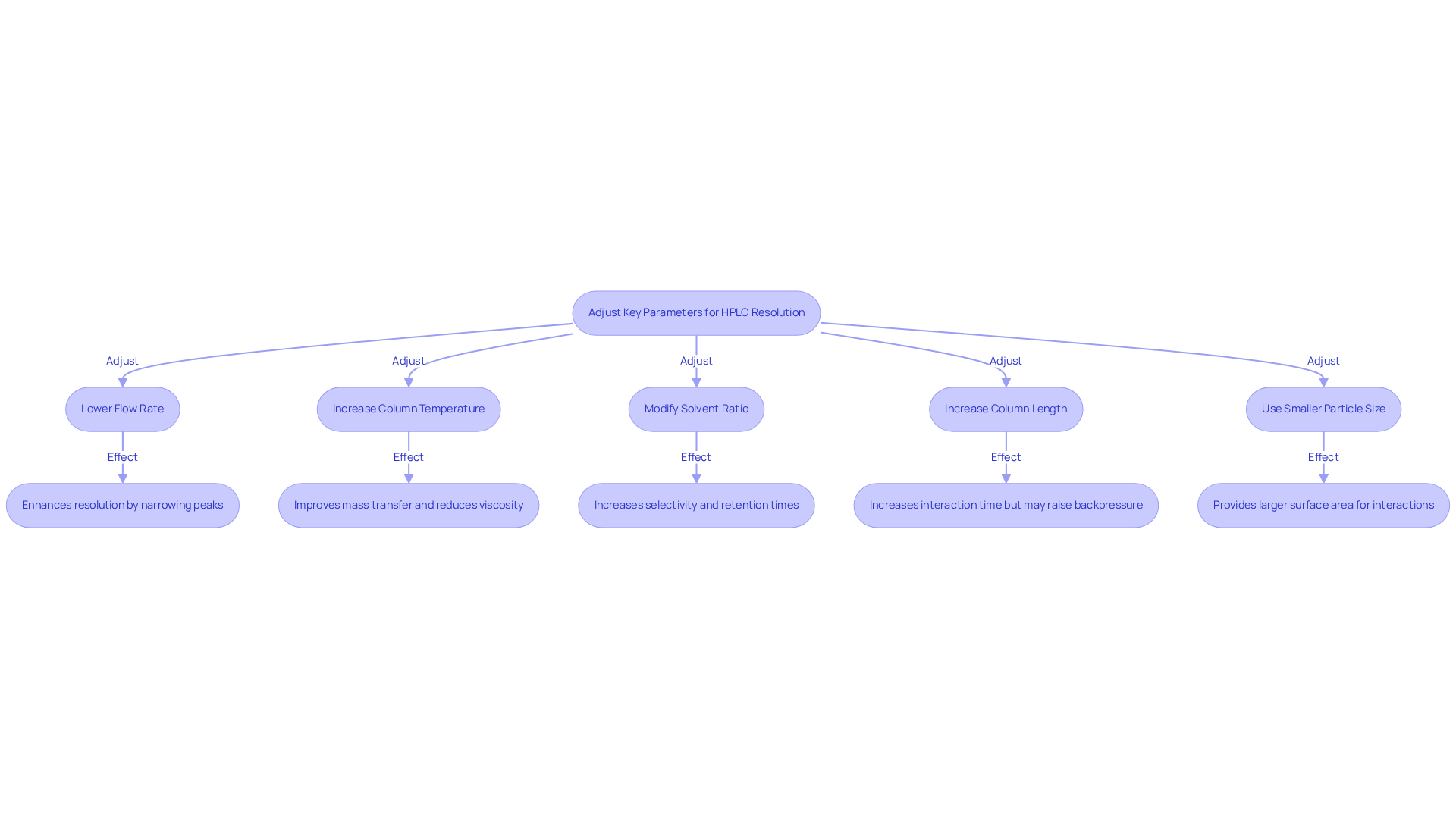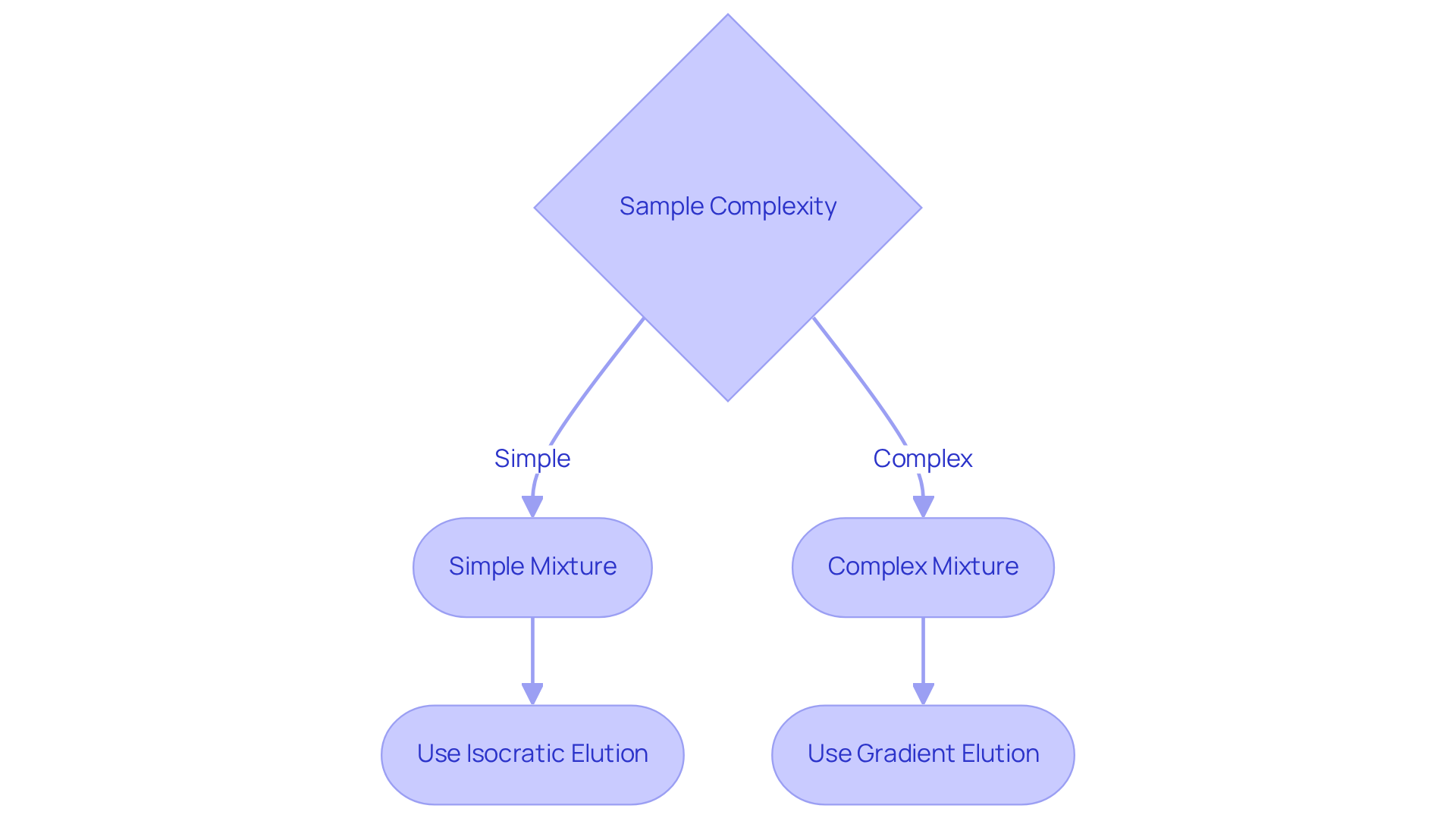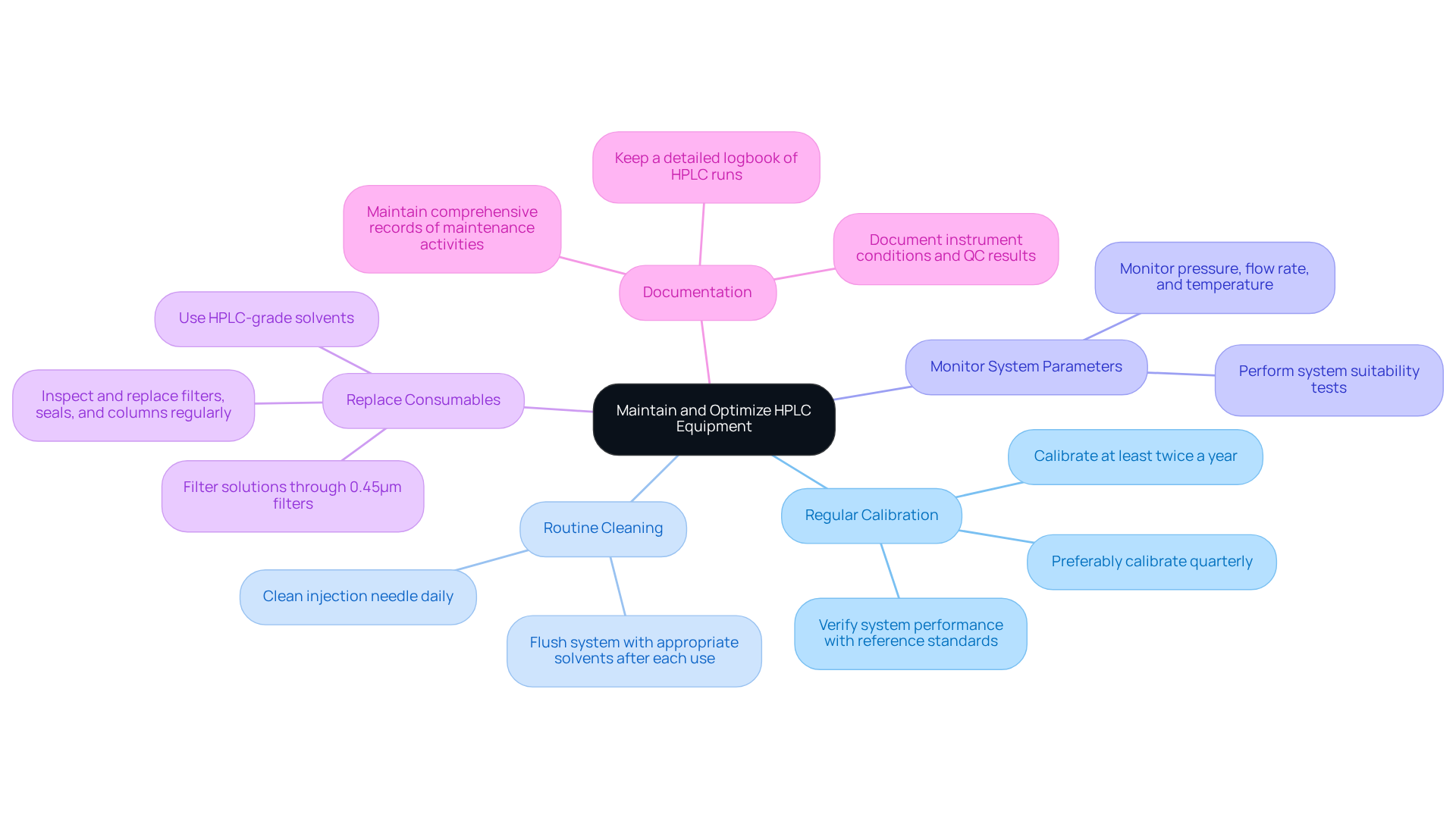Overview
This article outlines essential steps that lab managers can implement to master High-Performance Liquid Chromatography (HPLC) resolution.
Understanding fundamental concepts is crucial, as is the ability to adjust key parameters effectively. Selecting appropriate elution techniques and maintaining equipment are also vital components of achieving optimal results.
By optimizing column efficiency and adjusting flow rates, lab managers can significantly enhance peak separation and analytical performance in HPLC processes.
These strategies not only improve the effectiveness of HPLC operations but also support the overall quality of laboratory outcomes.
Introduction
In the intricate world of chromatography, distinguishing between closely eluting compounds is paramount, with HPLC resolution standing at the forefront of this challenge. Lab managers play a crucial role in optimizing this critical metric, influencing not only the accuracy of analyses but also the overall efficiency of laboratory operations. However, with numerous variables at play—from column efficiency to elution techniques—how can one ensure that their HPLC systems deliver the best possible results? This article explores essential strategies and best practices for enhancing HPLC resolution, empowering laboratory professionals to refine their methodologies and achieve unparalleled analytical performance.
Understand HPLC Resolution Fundamentals
HPLC resolution serves as a critical quantitative metric, illustrating how effectively two maxima can be differentiated during chromatographic division. Mathematically, it is expressed by the equation:
R_s = (t_R2 - t_R1) / ((w_1 + w_2) / 2)
In this equation, t_R signifies the retention times of the two peaks, while w represents their widths at the base. A value of 1.5 or greater is generally deemed acceptable for effective distinction. Several key factors influence resolution:
- Column Efficiency: Enhanced column efficiency leads to sharper peaks, which is essential for precise analysis.
- Selectivity: This refers to the stationary phase's ability to differentiate between various compounds, significantly impacting the quality of the division.
- Retention Time: The time a compound remains in the column directly affects peak separation; longer retention times typically yield improved clarity.
Understanding these fundamentals is vital for lab managers to make informed adjustments that enhance HPLC resolution in their processes. Case studies have illustrated that enhancing column efficiency through the use of smaller particle sizes can significantly improve HPLC resolution. Furthermore, expert insights underscore the necessity of selecting the appropriate stationary phase to boost selectivity, which is crucial for achieving optimal HPLC resolution and enhancing overall analytical performance. By grasping and applying these principles, laboratories can achieve more reliable and reproducible results in their chromatographic analyses.

Adjust Key Parameters for Enhanced Resolution
To improve HPLC resolution, it is essential to methodically adjust several key parameters that can significantly impact performance.
-
Lowering the flow rate can greatly enhance HPLC resolution by allowing additional time for analyte separation. For instance, reducing the flow rate to 0.5 mL/min can yield sharper signals and improved response factors, which contributes to better HPLC resolution by decreasing the retention factor at the column outlet. However, this adjustment may extend the analysis duration, necessitating careful consideration.
-
Increasing the column temperature reduces the mobile phase viscosity, which facilitates faster flow rates and improves HPLC resolution. For example, raising the temperature from 30°C to 50°C can enhance mass transfer. It is crucial to exercise caution, as excessively high temperatures (above 60°C) may degrade thermolabile compounds, potentially compromising results.
-
Modifying the solvent ratio in the mobile phase can significantly influence the HPLC resolution, as well as selectivity and retention times. For instance, increasing the organic solvent concentration can enhance clarity for specific analytes. A notable case study demonstrated the effectiveness of a HILIC column in differentiating glucose and fructose by elevating the organic solvent concentration to 80% acetonitrile. This underscores the necessity of meticulously considering mobile phase parameters to ensure high HPLC resolution during method development.
-
Column Length: Employing a longer column (150-250 mm) can improve HPLC resolution due to increased interaction time; however, this may also lead to longer run times and elevated backpressure, which should be factored into the analysis.
-
Particle Size: Utilizing smaller particle sizes (e.g., sub-2 µm particles in UPLC) in the stationary phase can enhance clarity and increase HPLC resolution by providing a larger surface area for interactions. This results in sharper peaks and quicker, high-definition separations, further optimizing the analysis.
Applying these modifications with a methodical approach will allow for observation of their impact on clarity, enabling the determination of the most effective configurations for specific applications.

Select Appropriate Elution Techniques
Choosing the right elution technique is essential for enhancing HPLC resolution.
Isocratic Elution: This method employs a constant solvent composition throughout the analysis, making it ideal for simpler mixtures where analytes exhibit similar retention times. Its straightforward nature ensures reproducibility and ease of management, thereby reducing operational costs and method development time. Isocratic elution is particularly effective when dealing with samples containing fewer than ten weakly retained components, as it streamlines the analytical process and maintains consistent detector responses. Moreover, isocratic elution is typically quicker and more economical for straightforward analyses, making it appealing for regular processes.
Gradient Elution: In contrast, gradient elution involves dynamically altering the solvent composition during the run. This technique greatly improves HPLC resolution for complex mixtures by enabling better distinction of analytes with differing polarities. It is particularly advantageous for samples defined by a wide variety of retention durations, as it offers unparalleled adaptability in enhancing separation conditions. Studies have shown that gradient elution can lead to shorter analysis times compared to isocratic elution without sacrificing repeatability in key metrics such as retention time and peak area.
When choosing between these methods, it is essential to consider the intricacy of your sample and the intended clarity. For more intricate samples, gradient elution is often the preferred choice, while isocratic elution may suffice for routine analyses where simplicity and cost-effectiveness are paramount.

Maintain and Optimize HPLC Equipment
To maintain and optimize HPLC equipment for improved HPLC resolution, it is crucial to adhere to best practices that ensure peak performance and reliability.
-
Regular Calibration: Calibration of all components, including pumps and detectors, is essential for accuracy. Equipment should be calibrated at least twice a year, ideally quarterly, to ensure precision in analyses. Most service contract options include one annual preventive maintenance (PM) per instrument, highlighting the importance of regular calibration to prevent unexpected downtime.
-
Routine Cleaning: System cleanliness is vital to prevent contamination and buildup that can compromise performance. Flushing the system with appropriate solvents after each use is recommended to maintain optimal conditions.
-
Monitor System Parameters: Vigilantly monitor critical parameters such as pressure, flow rate, and temperature. Variations from set standards can indicate potential issues that may adversely affect solutions and overall system performance. Performing system suitability tests to verify calibration is also crucial in this regard.
-
Replace Consumables: Regular inspection and replacement of consumables, including filters, seals, and columns, are essential for sustaining optimal performance. Utilizing HPLC-grade solvents and filtering all solutions through 0.45μm filters can further enhance system reliability.
-
Documentation: Maintain comprehensive records of maintenance activities, calibrations, and any encountered issues. It is particularly important to keep a detailed logbook of HPLC runs, including instrument conditions and quality control (QC) results. This documentation is invaluable for identifying patterns and preventing future problems, ensuring a proactive approach to instrument management.
By implementing these maintenance strategies, you can ensure that your HPLC system operates at peak performance, which will enhance HPLC resolution and reliability in your analyses. Regular calibration and maintenance not only enhance the quality of results but also contribute to the longevity of the equipment, ultimately supporting the integrity of your laboratory's work.

Conclusion
Mastering HPLC resolution is paramount for lab managers aiming to enhance the precision and reliability of chromatographic analyses. An in-depth understanding of the fundamental principles governing HPLC resolution—such as column efficiency, selectivity, and retention time—enables laboratory professionals to make informed decisions that optimize their processes. These foundational concepts are the backbone of effective analytical practices and are critical for achieving high-quality results.
Throughout this article, various strategies have been outlined to improve HPLC resolution. Key adjustments include:
- Modifying flow rates
- Increasing column temperature
- Altering solvent ratios
- Selecting appropriate elution techniques
These adjustments can significantly influence the clarity and separation of analytes. Furthermore, maintaining and optimizing HPLC equipment through regular calibration, cleaning, and monitoring is essential to ensure peak performance and longevity. These practices not only enhance resolution but also contribute to the overall integrity of laboratory work.
In summary, the significance of mastering HPLC resolution cannot be overstated. By implementing the insights and strategies discussed, lab managers can cultivate a culture of excellence in their analytical practices. Embracing these techniques will lead to more reliable and reproducible results, positioning laboratories to meet the evolving demands of scientific inquiry. Prioritizing HPLC resolution is a decisive step toward achieving analytical excellence and maintaining a competitive edge in the field.




